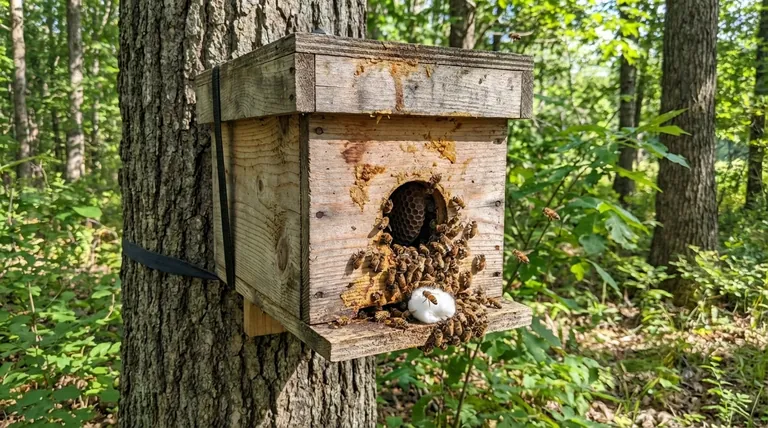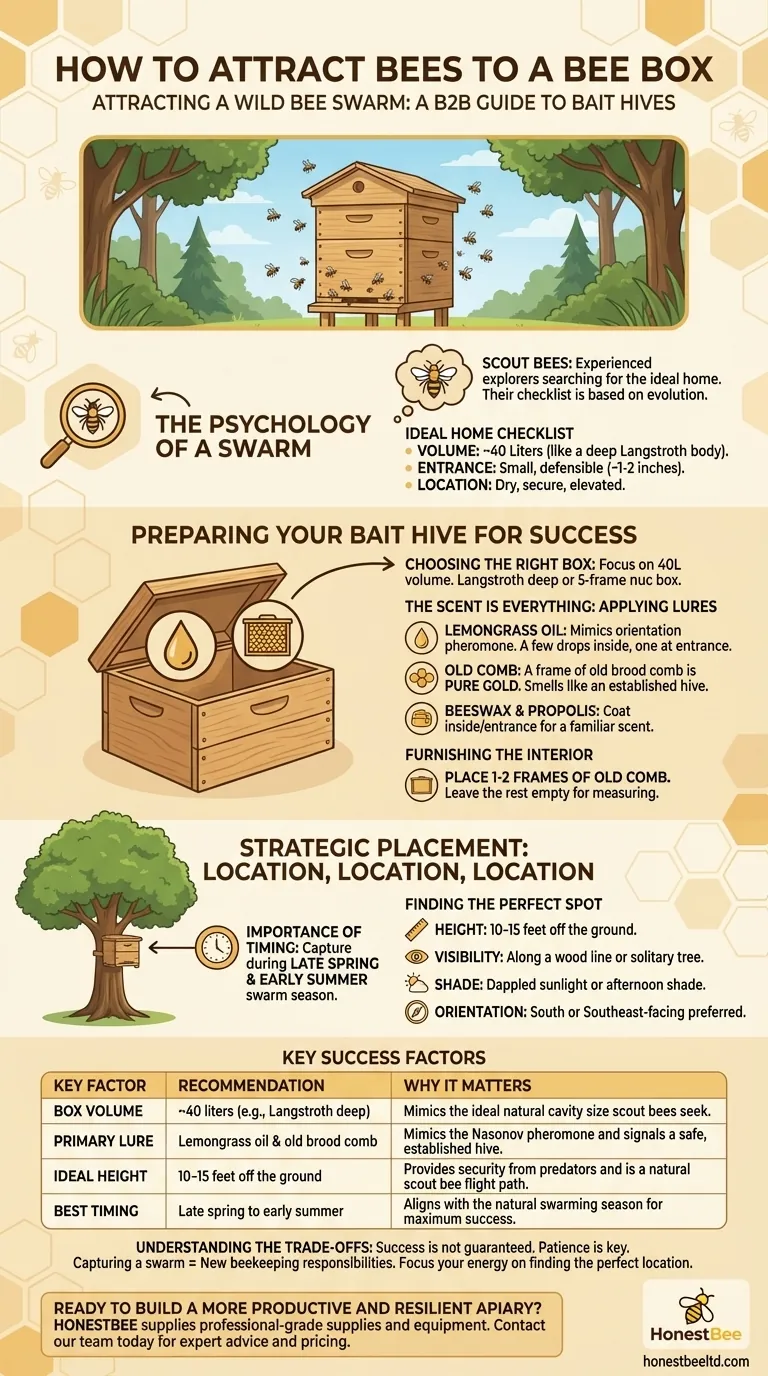Attracting a wild bee swarm to a bee box, often called a bait hive or trap, involves mimicking the ideal natural home that scout bees are searching for. To do this, you must appeal to their powerful sense of smell by using familiar scents like old beeswax or specific lures, and provide a cavity of the correct size and location. Success hinges on making your box the most appealing option for a swarm seeking a new residence.
A successful swarm trap is more than just bait; it's a carefully crafted illusion. Your goal is to convince scout bees that your box is a safe, established, and perfectly sized tree cavity, which requires a strategic combination of scent, size, and placement.

The Psychology of a Swarm: What Bees Are Looking For
To attract bees, you must first understand what they want. When a colony swarms, it sends out experienced "scout bees" to find a suitable new home. Your bait hive is an audition for these scouts.
The Role of Scout Bees
A swarm doesn't move randomly. It first clusters on a nearby branch while scout bees fly out in all directions, sometimes for miles, searching for a permanent cavity. They then return and "report" on their findings to the swarm through a complex dance, advocating for the location they found. Your job is to win this debate.
The Ideal Home Checklist
Scout bees operate from a specific checklist honed by millions of years of evolution. The most desirable homes generally share these traits:
- Volume: A cavity of around 40 liters (roughly the size of a standard deep Langstroth hive body).
- Entrance: A small, easily defensible entrance, about 1-2 inches in diameter.
- Location: A dry, secure spot, typically elevated off the ground.
The Decisive Power of Scent
Above all, scout bees are guided by scent. The smell of an existing or former colony is the strongest possible signal that a location is safe and suitable for bees. This is the primary tool you will use to make your box irresistible.
Preparing Your Bait Hive for Success
Creating a convincing bait hive is an exercise in applied bee biology. Every element should be chosen to appeal to the instincts of a scout bee.
Choosing the Right Box
The specific type of box is less important than its internal volume. A standard Langstroth deep box or a 5-frame nucleus (nuc) box are both excellent choices. What matters is that the volume is close to the 40-liter sweet spot.
The Scent Is Everything: Applying Lures
This is the most critical step. You want your new box to smell like an old, established hive.
- Lemongrass Oil: This is the most effective and widely used swarm lure. It mimics the bees' "Nasonov" orientation pheromone. Place a few drops on a cotton ball inside the hive and a single drop at the entrance.
- Old Comb: If you can acquire it, a frame of old, dark brood comb is pure gold. The scent of beeswax, old cocoons, and residual pollen is a powerful attractant.
- Beeswax & Propolis: As noted in the references, coating the inside of the box and the entrance with melted beeswax or rubbing propolis around creates a familiar, welcoming scent.
Furnishing the Interior
Do not fill the box with frames. A scout bee needs to enter and measure the internal volume. Place one or two frames of old comb against one wall and leave the rest of the space empty. This provides the crucial scent while allowing the scout to confirm the box is the right size.
Strategic Placement: Location, Location, Location
Where you put your bait hive is just as important as how you prepare it. A perfect box in the wrong place will be ignored.
The Importance of Timing
You can only catch a swarm during swarm season, which typically occurs in late spring and early summer. Placing traps outside of this window is unlikely to yield results.
Finding the Perfect Spot
Think like a scout bee looking for a prominent, safe location.
- Height: 10 to 15 feet off the ground is ideal. This puts the hive at a natural height and out of the way of most predators.
- Visibility: Place the trap along a wood line or in a solitary tree where it is easily visible to flying bees.
- Shade: Dappled sunlight or afternoon shade is best. A box in full sun can fatally overheat a new swarm.
- Orientation: A south or southeast-facing entrance is often preferred, but not a strict requirement.
Understanding the Trade-offs and Responsibilities
Swarm trapping is a rewarding practice, but it's important to have realistic expectations and understand your role.
This is a Game of Patience
Success is not guaranteed. Experienced beekeepers may set out half a dozen traps and only catch one or two swarms in a season. Do not be discouraged if your trap remains empty for weeks or even the entire first year.
Capturing vs. Buying Bees
Trapping a swarm gives you free, genetically resilient bees that are already adapted to your local environment. However, buying a package or a nucleus colony from a reputable supplier is the only way to guarantee you will have bees on a specific timeline.
The Responsibility of Capture
If you successfully capture a swarm, you are now a beekeeper. You have a responsibility to care for the colony, which includes moving them to a permanent apiary location, managing for pests like Varroa mites, and ensuring they have the resources to thrive.
Making the Right Choice for Your Goal
Your approach should be tailored to your specific objective.
- If your primary focus is maximizing your chances of a free hive: Combine a 40-liter box, one frame of old dark comb, and a lemongrass oil lure, and securely place it 10-15 feet high in a visible tree during peak swarm season.
- If your primary focus is beekeeping on a tight budget: An old wooden box of the right size and a vial of lemongrass oil are your most critical investments. Focus your energy on finding the perfect location.
- If your primary focus is a guaranteed start this season: Purchase a nucleus colony (nuc) from a local beekeeper, as this provides an established colony with a laying queen and is the surest path to success.
By understanding the instincts of a swarm, you can transform an empty box into an irresistible new home.
Summary Table:
| Key Factor | Recommendation | Why It Matters |
|---|---|---|
| Box Volume | ~40 liters (e.g., Langstroth deep) | Mimics the ideal natural cavity size scout bees seek. |
| Primary Lure | Lemongrass oil & old brood comb | Mimics the Nasonov pheromone and signals a safe, established hive. |
| Ideal Height | 10-15 feet off the ground | Provides security from predators and is a natural scout bee flight path. |
| Best Timing | Late spring to early summer | Aligns with the natural swarming season for maximum success. |
Ready to build a more productive and resilient apiary?
As a commercial beekeeper or equipment distributor, efficiently populating your hives is critical to your operation's success. HONESTBEE supplies the professional-grade beekeeping supplies and equipment you need—from durable swarm traps and nuc boxes to effective lures—to help you manage your colonies effectively and scale your business.
Let's discuss how our wholesale-focused solutions can support your goals. Contact our team today for expert advice and pricing.
Visual Guide

Related Products
- HONESTBEE Professional Long Handled Hive Tool with Precision Cutting Blade
- 5 Frame Wooden Nuc Box for Beekeeping
- HONESTBEE Advanced Ergonomic Stainless Steel Hive Tool for Beekeeping
- HONESTBEE Professional Multi-Functional Hive Tool with Ergonomic Wood Handle
- Professional Dual-End Stainless Steel Hive Tool for Beekeeping
People Also Ask
- How can a hive tool be used to remove propolis and burr comb? Master Hive Maintenance for a Healthy Colony
- What is the hive tool used for? The Essential Multi-Tool for Every Beekeeper
- What are some common uses of a hive tool? Essential Multi-Purpose Tool for Every Beekeeper
- How should beekeepers handle bees when using a hive tool? Master Calm, Deliberate Techniques
- What is a hive tool used for in beekeeping? Your Essential Guide to Hive Management



















